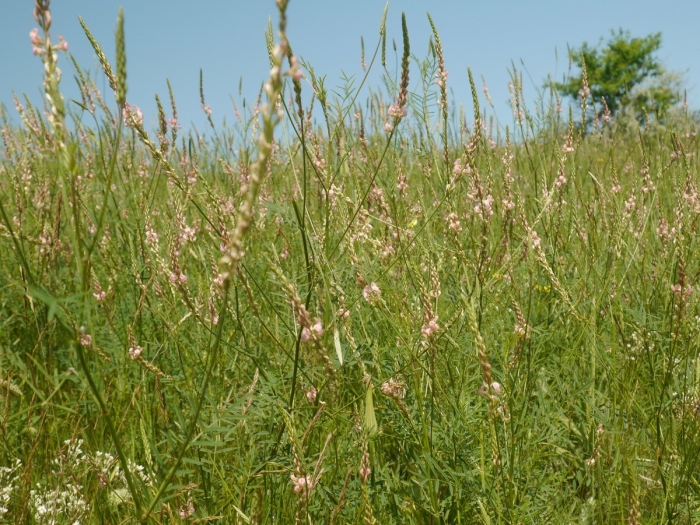Sainfoin
(Onobrychis arenaria)
Sainfoin (Onobrychis arenaria)
/
/

Roman
CC BY 4.0
Image By:
Roman
Recorded By:
Copyright:
CC BY 4.0
Copyright Notice:
Photo by: Roman | License Type: CC BY 4.0 | License URL: http://creativecommons.org/licenses/by/4.0/ | Rights Holder: Roman | Publisher: iNaturalist | Date Created: 2021-06-10T15:30Z |















































Estimated Native Range
Summary
Onobrychis arenaria, commonly known as Sainfoin, is a perennial herb that is native to grasslands, steppes, and open woodlands across Europe, Siberia, the Russian Far East, and Central Asia. It typically grows to a height of 3-5 feet (0.9-1.5 meters) and a width of about 0.3 feet (0.09 meters). Sainfoin has a distinctive appearance with upright stems, pinnate leaves, and showy spikes of pink to red flowers that bloom in late spring to early summer, attracting pollinators such as bees.
Sainfoin is valued for its nitrogen-fixing ability, which improves soil fertility, and its drought tolerance, making it suitable for xeriscaping. It is also used as forage for livestock due to its high nutritional value and palatability. In gardens, it can serve as an ornamental plant or be incorporated into wildflower meadows. Sainfoin thrives in full sun and requires well-drained soils, preferably alkaline. It is relatively low-maintenance, needing minimal water once established. However, it can be potentially invasive outside its native range, so gardeners should consult local regulations before planting.CC BY-SA 4.0
Sainfoin is valued for its nitrogen-fixing ability, which improves soil fertility, and its drought tolerance, making it suitable for xeriscaping. It is also used as forage for livestock due to its high nutritional value and palatability. In gardens, it can serve as an ornamental plant or be incorporated into wildflower meadows. Sainfoin thrives in full sun and requires well-drained soils, preferably alkaline. It is relatively low-maintenance, needing minimal water once established. However, it can be potentially invasive outside its native range, so gardeners should consult local regulations before planting.CC BY-SA 4.0
Plant Description
- Plant Type: Herb
- Height: 2.5-5 feet
- Width: 0.15-0.3 feet
- Growth Rate: Moderate
- Flower Color: Pink
- Flowering Season: Spring
- Leaf Retention: Deciduous
Growth Requirements
- Sun: Full Sun
- Water: Low
- Drainage: Fast
Common Uses
Bee Garden, Drought Tolerant, Edible*Disclaimer: Easyscape's listed plant edibility is for informational use. Always verify the safety and proper identification of any plant before consumption., Low Maintenance
Natural Habitat
Grasslands, steppes, and open woodlands
Other Names
Common Names: Sand Esparcet, Sand-Esparsette, Sand-Esparcette, Smiltaju Esparsete, Esparcet PesČAnyj
Scientific Names: , Onobrychis arenaria, Onobrychis viciifolia subsp. arenaria, Hedysarum arenarium, Hedysarum pallescens, Onobrychis sativa var. arenaria,
GBIF Accepted Name: Onobrychis arenaria (Kit.) DC.